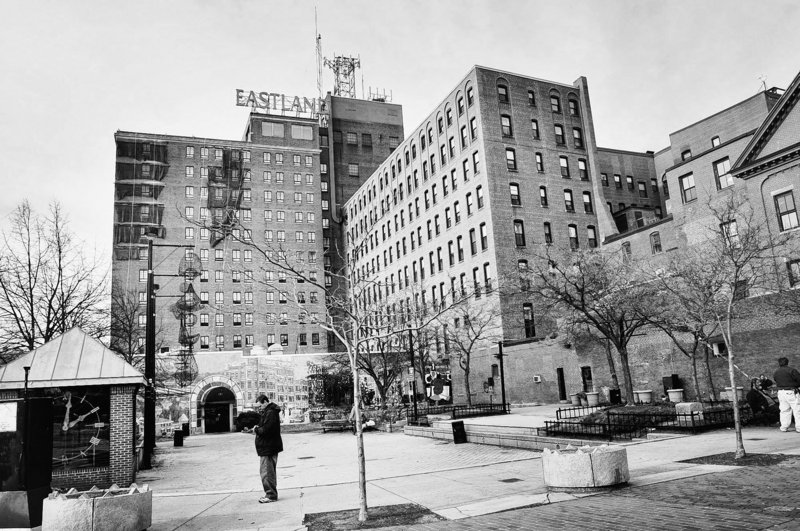Great design never comes easily – it takes hard work, imagination, willingness to take chances and the right context! Congress Square Plaza may be that location.
Consider: a single-story ballroom facility with an accessible, planted public plaza on its roof.
There are many examples of this in this country.
One of the first was the Pioneer Courthouse Square in Portland, Ore., where private and public interests came together to make a vibrant public square with private retail (clothing stores, copy shops and restaurants) above and below street grade.
A new and popular (but hard-fought) success story is the High Line in New York City.
Since the ’70s, New York has provided “incentive zoning” – municipal legislation and planning that encouraged developers to provide public park space within their developments in exchange for exceptional tax credits, as well as some protections from liabilities that might dissuade a private owner from allowing the public to occupy a private park.
It allows for multiple uses throughout the day, and attracts different populations, including local dwellers, shoppers and workers on break. In the past 10 years, there have been exceptional advances in planted roof systems at a few dollars a square foot more than a typical rubber-membrane roof system.
At Congress Square, it’s a matter of scale. This location is in the heart of the arts district, next to one of the most unusual and successful museums in the country, multiple music venues, restaurants, and parking garages and lots.
The fact that this property is not too large offers the opportunity to make it a gem – a private celebration space below and a community park above.
I hope the owners, our city councilors and our Planning Board can see that there is exceptional potential for this location – and not just as another building envelope that fills a commercial void and removes a public space from community memory.
Jeremy Moser
Portland
Did I miss something? Do the owners of the Eastland Park Hotel think no one remembers that they eliminated 54 low-income apartments from their hotel and avoided paying $2.5 million in fees to Portland a year ago?
How can these same people propose to develop a ballroom on what is now a public park? And it’s not just any park, it’s a park that is frequented by the same people they displaced from their low-income apartments.
That the city of Portland’s leaders would even consider such a proposal is outrageous. Or maybe they, too, think no one remembers.
Jay (photographic memory) York
Portland
Thompson’s Point project should inspire creativity
I attended the recent Portland Planning Board hearing regarding the new development for Thompson’s Point. Whatever is done there will be a vast improvement over the present prominent eyesore that greets all comers to this grand area.
This is an opportunity to build a most attractive complex that could be an icon for a great city. I’m not sure that the contemplated box structures demonstrate the imagination that could characterize this unique site.
In the planning to come, I hope the developers and the city will be truly creative. Wouldn’t it be terrific to have a structure as iconic for Portland and Greater Portland as is the Opera House for Sydney, Australia. Too much to dream?
Wayne Newland
Falmouth
Traip’s Coach Lajeunesse didn’t let cancer defeat him
In 1985, our Traip Academy football team went 0-8. There was serious discussion about eliminating the program. As the quarterback of that team, I felt almost as much responsibility as our coach – Guy Lajeunesse.
One year later, we beat Wells, Kennebunk, Massabesic, Noble and York, all schools much larger than Traip. The next year, Traip went on to the state semifinals. Under head coach Guy Lajeunesse, “Ranger Pride” had been restored in just three short years.
Coach Lajeunesse was a testament to the axiom that one man’s life touches so many. I am reminded each day of the life lessons we learn from coaches and teachers that remain with us for the long haul.
Coach Lajeunesse taught all who played for him that athletics, like life, is a constant struggle against the self; that character is more important than image; that how you conduct yourself matters – on and off the field; that defeat should harden one’s resolve, not break it.
I remember in particular, that after we were defeated, he would jog by us and shout enthusiastically, “Chins up! Chins up!” He knew the only real defeat in life was resignation of the spirit.
“Coach” lived as he coached. When he was hit by cancer, he still rose to his feet. Not for one moment did he give the disease the part of him that it could not take – his spirit. To all those who knew him, “Chin up.”
Dean Scontras
Leesburg, Va.
Loosening gun regulations would hamper public safety
With all respect to Robert Milholland, his Another View predictions of the value of arming people in times of crisis weren’t very accurate (“Confiscating guns during crises would make us less safe,” May 8).
First of all, the number of times that guns abate crises pales enormously to the number of times guns result in tragedy. Secondly, one of the things I learned at the Maine Criminal Justice Academy was how remarkably difficult it was to fire a handgun safely.
Reckless and malicious conduct will wildly outnumber the safe uses of guns in critical situations. The only positive claims are anecdotal – there is no evidence anywhere to suggest an armed citizenry is safer than an unarmed one.
Andrew Michaelson
Portland
Send questions/comments to the editors.



Comments are no longer available on this story